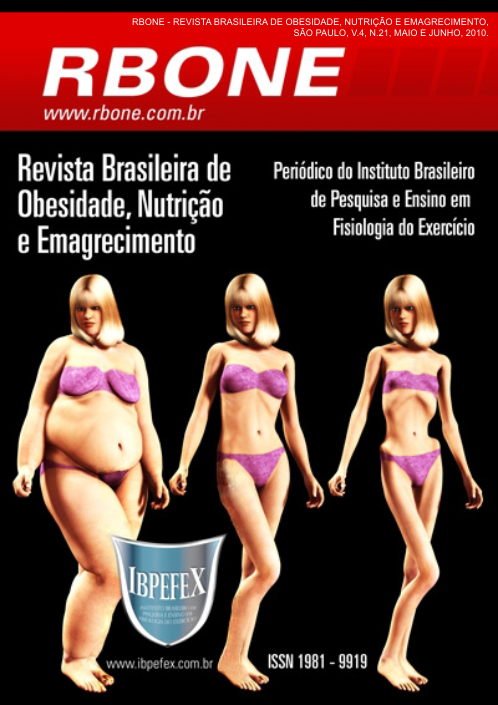Metabolic syndrome and eating habits: approach to diet and co-factors associated with the emergence of the metabolic syndrome in patients seen in cardiology clinic in Sorocaba-SP -Cardio Center
Abstract
Metabolic syndrome has gained the scale as one of the main challenges of clinical practice in this new century. It is recognized as a complex pathology involving cardiovascular risk factors and established players such as hypertension, hypercholesterolemia, diabetes, among others, such as central adiposity and insulin resistance. Thus, physical inactivity and poor nutritional habits appear to pose a major risk factor in obesity worldwide and consequently the metabolic syndrome. Aiming to check the dietary habits, co-factors associated with the degree of knowledge of patients regarding the Metabolic Syndrome in Clinical Cardiology Cardio City of Sorocaba in the State of São Paulo, carried out a cross-sectional study and exploratory. We administered a questionnaire with approximately 100 patients, aged above 18 years. Among the results there was a low consumption of whole foods or complex carbohydrates in their diets and yet it was observed that they do not purchase products with reduced calories, so-called lights products.
References
-ADA -American Diabetes Association. Diagnosis and classification of diabetes mellitus. Diabetes Care. Vol. 27. suppl. 1. p. S5-S10. 2004.
-American College Sports of Medicine (ACSM). ACSM stand position on the apropriate intervention strategies for weight loss and prevention of wheight regain for adults. Med. Sci. Sport Exerc. Vol. 33. p. 2145-56 . 2001.
-Arquivos Brasileiros de Cardiologia. Vol. 84. Suplemento I. 2005.
-Durstine, J.L.; Haskell, W.L. Effects of exercise on plasma lipids and lipoproteins. Exerc Sport SCi Rev. Vol. 22. p. 477-521.1994.
-Ferreira, S.R.G.; e colaboradores. Effects of an intervention in eating habits and physical activity, in Japanese –Brazilian women with high prevalence of metabolic syndrome, in Bauru, São Paulo State, Brazil. Cad. Saúde Pública. Vol. 24. Núm. 2, p. S294-S302. 2008.
-Heno, F.L.; Brent, M. E. Desequilíbrio Autonômico e Síndrome Metabólica: Parceiros patológicos em uma Pandemia Global Emergente. Arq. Bras Cardiol. Vol. 87. p. 538-547. 2006.
-Jebb, S. A. Obesity: from molecules to man. Proc Nutr Soc. Vol. 58. p. 1-14. 1999.
-Lakka, T. A.; e colaboradores. Sedentary life style, poor cardiorespiratory fitness, and the metabolic syndrome. Med. Sci. Sports Exerc. Vol. 35. p. 1279-86. 2003.
-Mahan, L. K.; Escott-Stump, S. Krause. Alimentos, nutrição e dietoterapia. São Paulo. Roca. 1998.
-Mello, V. D.; Laaksonen, D.E. Fibras na dieta: tendências atuais e benefícios à saúde na síndrome metabólica e no diabetes melito tipo 2. Arq. Bras. Endocrinol, Metab. Vol. 53. Núm. 5. p. 509-18. 2009.
-Meyer,K.;ecolaboradores. Carbohydrates, dietary fiber, and incident type 2 diabetes in older women. Am. J. Clin. Nutr. Vol. 71. Núm. 4. p. 921-30. 2000.
-Miname, M. H.; Chacra, A. P. M. Síndrome metabólica. Rev Soc Cardiol. Vol. 15. Núm. 6. p. 482-9. 2005.
-Monteiro, C. A.; Conde, W. L. A tendência secular da obesidade segundo estratos sociais: nordeste e sudeste do Brasil, 1975-1989-1997. Arq Bras Endocrinol Metab. Vol. 43. p. 186-94. 1999.
-Oliveira, E. P.; Souza, M.L.A.; Lima, M.D.A. Prevalência de Síndrome Metabólica em um área rural do semi-árido Baiano. Arq. Bras. Endocrinol Metab. Vol. 50. Núm. 3. 2006.
-Pereira, L. O.; e colaboradores. Obesidade e suas implicações –Ação da Atividade Física e Controle Nutricional. Rev. Brás. Nutr. Clin. Vol. 14. p. 9-17. 1999.
-Pozzan, R.; Pozzan, R.; Magalhães, M. E. C.; Brandão, A.A.; Brandão, A. P. Dislipidemia, síndrome metabólica e risco cardiovascular. RSOCERJ. Vol. 17. Núm. 2. p. 97-104. 2004.
-Sociedade Brasileira de Hipertensão-SBH, Sociedade Brasileira de Cardiologia-SBC, Sociedade Brasileira de Endocrinologia e Metabologia-SBEM, Associação Brasileira para Estudos da Obesidade-ABEO, I diretriz Brasileira para diagnóstico e tratamento. Hipertensão. Vol. 7. Núm. 4. p. 130-59. 2004.
-WHO -World Health Organization. Obesity -preventing and managing the global epidemic. Geneva.Report of a WHO Consultation on Obesity, 1998.
-WHO Obesity: Preventing and managing the global epidemic: Report of a Who Consultation on Obesity, Geneva, 3 -5 June 1997.
Authors who publish in this journal agree to the following terms:
- Authors retain the copyright and grant the journal the right of first publication, with work simultaneously licensed under the Creative Commons Attribution License BY-NC which allows the sharing of the work with acknowledgment of the authorship of the work and initial publication in this journal.
- Authors are authorized to enter into additional contracts separately for non-exclusive distribution of the version of the work published in this journal (eg, publishing in institutional repository or book chapter), with acknowledgment of authorship and initial publication in this journal.
- Authors are allowed and encouraged to post and distribute their work online (eg, in institutional repositories or on their personal page) at any point before or during the editorial process, as this can bring about productive change as well as increase impact and impact. citation of published work (See The Effect of Free Access).






